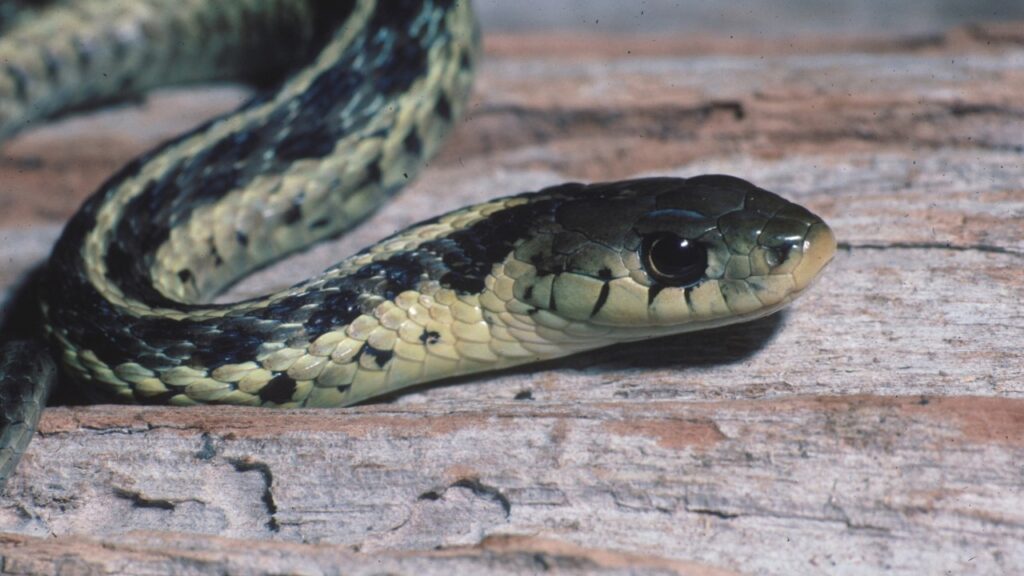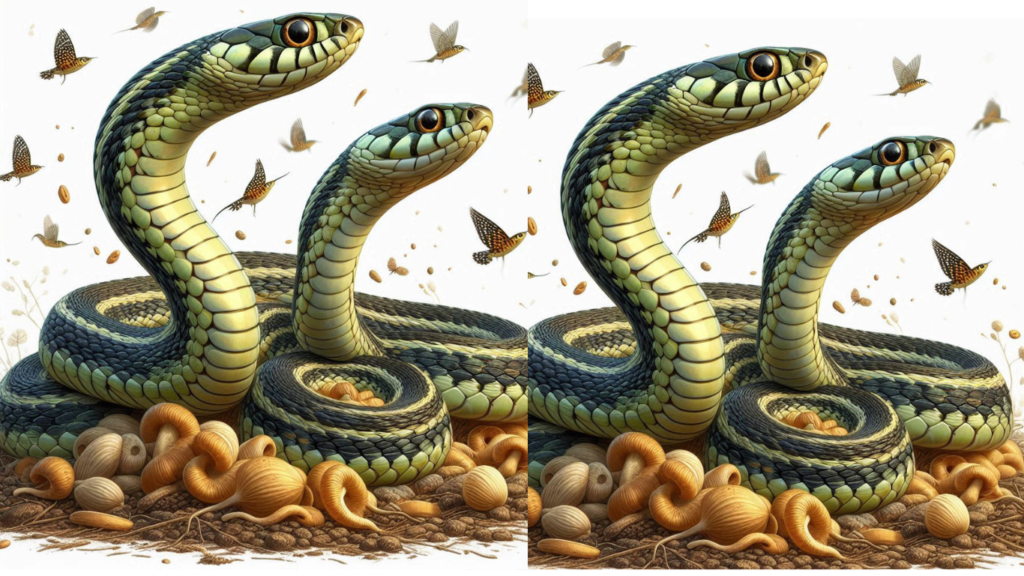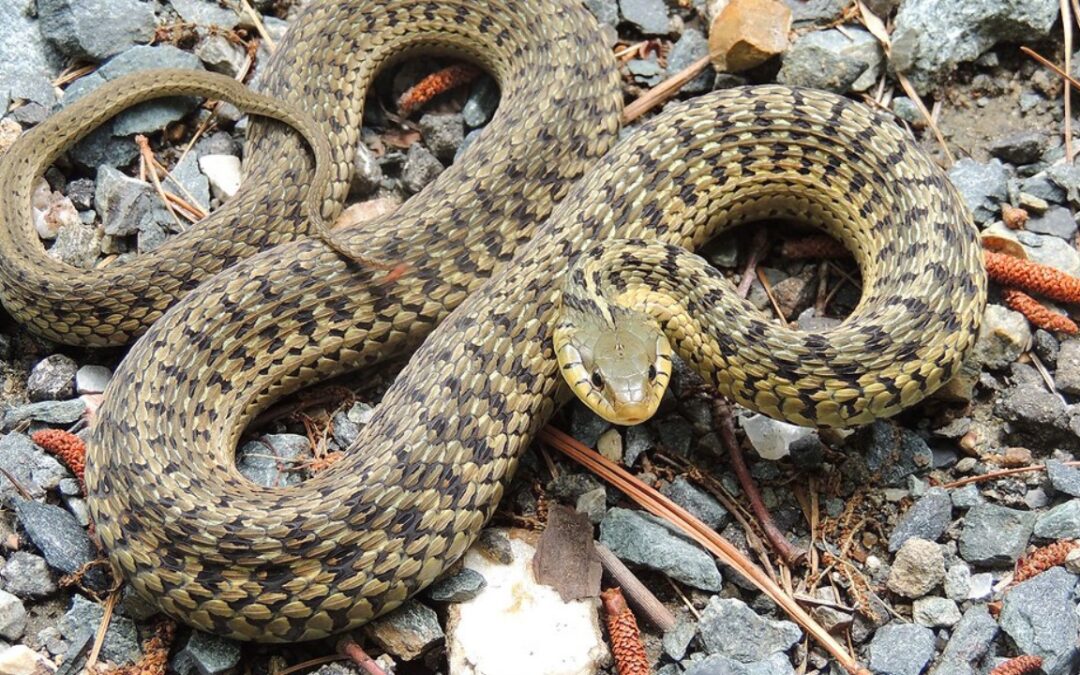What is an Eastern Garter Snake?

Did you know that the Eastern Garter Snake (Thamnophis sirtalis sirtalis) ranks among North America’s most versatile reptiles? Its ubiquity in varied environments, ranging from wetlands to city gardens, reflects its hardness. Aside from its flexibility, this non-venomous snake is also a key pest population controller, thus a vital part of local systems.
This article discusses the Eastern Garter Snake’s characteristics, habitat, diet, behavior, and its relationship with humans.
Physical Description: What Does an Eastern Garter Snake Look Like?
The Eastern Garter Snake is elongated and slender, usually ranging from 18 to 26 inches in length, similar to the size of a typical ruler. The smooth scales make them shiny, with three longitudinal stripes extending from head to tail. The middle stripe is usually more robust, colored from olive green to dark brown or black, depending on location and genetics. A checkerboard pattern between the stripes is seen in some individuals, and some populations show red or orange colors. Juveniles have brighter colors, which serve as camouflage and to avoid predators.
Taxonomy and Classification
The Eastern Garter Snake belongs to the common garter snake (Thamnophis sirtalis). But it differs from other subspecies throughout North America by its distinctive stripe arrangement and coloring.
Habitat and Distribution: Eastern Garter Snake Habitat
Eastern Garter Snakes are very versatile, and they live well in a variety of environments:
- Wetlands: Lakes, ponds, streams, and marshes.
- Forests and Grasslands: Wooded swamps and open fields.
- Urban and Suburban Landscapes: Parks, gardens, and empty lots.
They live in wetlands, grasslands, and lake/river shores in Michigan, indicating their appreciation for varied terrain. Likewise, in Virginia, they live in meadows, marshes, forests, and hillsides, commonly in association with lakes and streams. Their occurrence both in the countryside and in the city indicates their flexibility.
Behavior

Activity Patterns
Mainly diurnal, Eastern Garter Snakes are active during the day but can become crepuscular or nocturnal on extremely hot summer days to prevent overheating. But, they will often bask on rocks, logs, or open ground during the cooler part of the day to thermo-regulate.
Brumation
In winter, they also brumate—a sort of hibernation—pursuing communal dens known as hibernacula within underground burrows, crevices within rocks, or other sheltered locations. These dens help to insulate them against freezing temperatures. Occasionally, they will emerge on warm days to drink water or shift within the den.
Defense Mechanisms
Eastern Garter Snakes will respond to threats by:
- Flattening their bodies in an attempt to present a larger appearance.
- Shaking their tails against dry leaves to simulate rattlesnakes.
- Emit a strong-smelling musk from glands along the tail.
- Defecate to repel predators.
Generally non-violent, they like to run away when attacked.
Diet: What Do Eastern Garter Snakes Eat?
Eastern Garter Snakes are opportunistic carnivores with several types of diet:
- Earthworms make up 60–95% of their diet.
- Amphibians: Frogs, toads, and salamanders.
- Fish: Small fish found in the surrounding water bodies.
- Insects and Leeches: Other invertebrates in the surroundings.
- Occasionally: Small rodents and birds.
Their diets seasonally and geographically vary as they respond to prey availability. So, Juveniles feed mostly on earthworms and small amphibians, while adults add larger amphibians and small mammals to the diet.
Reproduction and Lifespan
Mating takes place shortly after emergence from brumation in the spring. Males fight in “mating balls,” with many males competing for a single female. Females are pregnant for about 60 to 70 days after mating. As ovoviviparous animals, they give birth alive, with litters of 10 to 40, and occasionally up to 80. Newborns are mature at birth.
Most of the wild individuals survive around 2 years because of predation and environmental factors, but a few can survive up to 4–5 years; in captivity, they live between 6–10 years, with a infrequent individuals living for 20 years.
Interaction with Humans
Is the Eastern snake garter venomous?
Eastern Garter Snakes are not venomous and will not harm people. While Duvernoy’s gland secretion is technically a mild venom, it is not dangerous to humans and rarely causes more than minor irritation. They have a weak toxin that they use to immobilize small prey, but it will not impact humans.
Do They Bite?
Bites are uncommon and tend to cause mild irritation or swelling. If they bite, wash with soap and water. Consult a doctor if abnormal symptoms are experienced.
Encountering Them in the Wild
If you do encounter an Eastern Garter Snake, the best action is to observe from a far. Ecologically, they are useful, keeping pest populations under control, and don’t like to deal with humans.
Keeping them as Pets
Eastern Garter Snakes are among the favorites of novice reptile keepers because they are easy to handle and quite small. They require an enclosure of a minimum of 20 gallons with good ventilation and a tight lid. There should be a temperature gradient, a basking place at about 85°F (29°C), and a cooler place at about 70°F (21°C). Humidity can be kept at about 40-60% with a source of fresh water.
Legal Implications: It is a good idea to look up local laws before taking one as a pet, as wild snake laws are region-specific.
Conclusion: Ecological Role and Conservation
Eastern Garter Snakes keep insects and amphibian populations in balance. They prey on birds, mammals, and larger reptiles. The IUCN has not evaluated the Eastern Garter Snake subspecies, yet the parent species is “Least Concern.” The subspecies is “secure” according to NatureServe. The main threats are habitat loss, pollution, and road mortality. Conservation efforts involve the protection of the habitat and lessening human-wildlife conflict.
Therefore, inform people about why indigenous reptiles play a crucial role in keeping ecological balance.
Eastern Garter Snake FAQs
Are Eastern Garter Snakes poisonous, and will they hurt me?
No, Eastern Garter Snakes are not poisonous. They do not hurt people at all. While they secrete a mild toxin to immobilize tiny prey, this secretion is not effective on humans.
What do Eastern Garter Snakes eat, and what is their diet?
Eastern Garter Snakes feed mainly on earthworms, amphibians, fish, and insects. In addition, they sometimes eat rodents or small birds.
Do Eastern Garter Snakes hibernate?
Yes, Eastern Garter Snakes brumate in inclement weather. In most cases, they huddle together in clusters within underground burrows or rock crevices.
Are Eastern Garter Snakes pets?
These snakes are calm and mild, hence suitable as pets for beginners. Also, with their easy size and basic care needs, they are favored by beginners.
How long do Eastern Garter Snakes live?
In the wild, the majority of Eastern Garter Snakes survive an average of 2 years due to environmental hazards. However, with ideal care in captivity, they can survive 6–10 years and more.
References and Further Reading
- Conant, R., & Collins, J. T. (1998). A Field Guide to Reptiles and Amphibians: Eastern and Central North America. Houghton Mifflin Harcourt.
- National Wildlife Federation:
- Local Herpetological Conservation Organizations


Trackbacks/Pingbacks